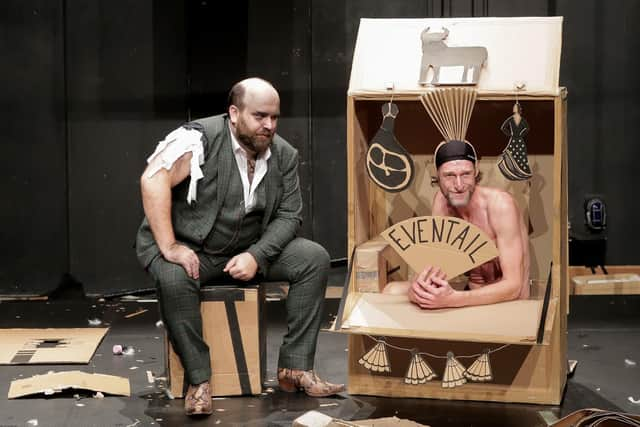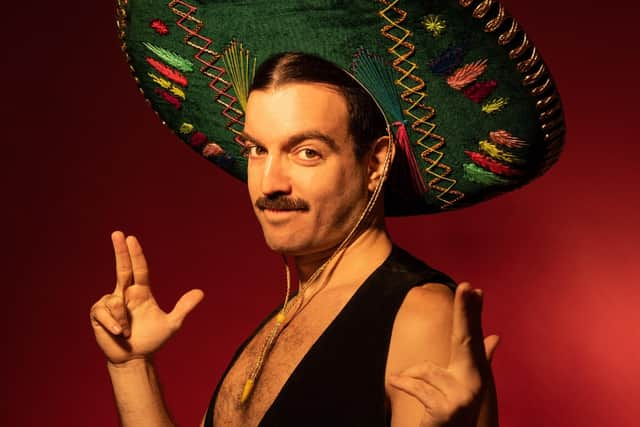Edinburgh Festival Fringe theatre reviews: The Ice Hole: A Cardboard Comedy | Playing Latinx | 4/4/4: 4 Real Asians, 4 White Men, 4 Fake Asians
The Ice Hole: A Cardboard Comedy ****
Pleasance Courtyard (Venue 33) until 28 August
Playing Latinx ****
Summerhall (Venue 26) until 27 August
4/4/4: 4 Real Asians, 4 White Men, 4 Fake Asians ****
theSpace @ Niddry St (Venue 9), run ended
A great thing about the Fringe is that sometimes you see two shows in a row that, together, make you think about something in a way that you perhaps wouldn’t if you had just seen the one. The Ice Hole: A Cardboard Comedy is a technically skillful, very funny and often ingenious physical theatre and clown show that fills the giant overheated box that is the Pleasance Grand with many more boxes: cardboard ones.


Playing a silent Laurel and Hardyesque clown-like duo, Pierre Guillois and Olivier Martin-Salvan (creators of 2019 Fringe hit Fishbowl) repurpose and write words on the boxes to create an escalating architectural feat of imagination. One plays a bumbling, small-minded man living in a Fjord-side fishing hut. The other plays everyone else and all of the set. Together, they go on an epic journey across Europe to in search of a missing mermaid in a gradually growing monolith of a show.
Boxes are broken down, opened up, written on and expanded – meticulously incorporating scale, form, perspective, sound, texture – into an ever-growing landscape of boats, buildings and tourist destinations. Ice skates become boots become espadrilles, before being impaled upon characters’ heads.
The commodification of Scottishness, with cheap macs and unskilled bagpiping has the audience laughing with recognition, while similar-but-different archetypes also fill the towns and beaches of Iceland, France and Spain. Dual meanings and proverbs are pushed to sometimes violent conclusions in what might look like a family show, but is actually something else.
One repeated sequence is particularly stark: hands labelled “migrants” reach up from the sea, before being violently dismissed by the main character. The audience, bizarrely, continue to chuckle along, even though it’s no longer funny. While this could be an admirable attempt to include a serious subject in the type of large-scale physical theatre show not exactly known it, there isn't sufficient time or attention given to developing it.


Instead, the show quickly moves on from the drowning people, leaving what could have been a thought-provoking comment on the dire situation in the English Channel under-explored in favour of something more crowdpleasing.
Playing Latinx is an interesting show to watch next, as a result. Here, Guido Garcia Lueches is also drumming up a raucous atmosphere, with Salsa music blaring and sombreros flaring. He is “emotional”, as he repeatedly says, but also, it becomes apparent, playing a part: that of a stereotypical persona – one third “sexy Mexican”, one third angry Latino of non-specific origin, and one third an actor from South America just trying to hold together a show that involves multiple costume changes and a fair amount of audience participation.
Framed around what’s described as a “politically incorrect seminar”, Guido (who’s from Uruguay) plays, parodies and pulls to bits all of what he terms as “the three emotions of Latinos”: characterised as a lover, a fighter, or comic relief. The actor he plays tells us that with his help, we too can become more Latino and cash in – like he has – on all the rewards that come from changing our identities to fit cultural and social cliches. A world where actors have to mine their identities for parts and – when they’re too middle-class, educated and similar to whoever’s auditioning them – ham up accents to appear more “Latino”.
Through a clever show-within-a-show type construct, he explores how some of us get typecast more than others – as well as the temptation to fit the roles others construct if it helps to get on. It’s a show hissed through his teeth – and as with his smile that turns into a snarl, it encourages us to sing, dance and chant along to the high-energy stereotypes, to both enjoy their appeal and, eventually, through a more heartfelt direct address, to feel their effects.
How many wars need to happen, people’s opportunities be destroyed and lives fetishised for us to understand? It’s a message repeated in many other shows at this year’s Fringe, including 4/4/4: 4 Real Asians, 4 White Men, 4 Fake Asians, which adapts a similar meta-theatrical structure – one that seems to suit the subversive goals of this kind of story well. The cliches never feel comfortable, and at times there’s a sense that shows such as these are pre-judging their audience in the same way they are discouraging such pre-judgment elsewhere.
However, by the time our gregarious host is back spurring us to sing along for the finale, the high energy that he throws out now feels marred by the pain that the show cleverly reveals lies beneath its sizzling facade.